
Day 16, Monday October 7 – Kiligolf to Castle Lodge Kenya
This is part 2 of the trip I did with Sybrand van Niekerk from South Africa. Sybrand was doing an African big birding year in 2019. We had just finished 2 weeks in Tanzania where he ended up with 119 new birds taking his total African count to 1285 birds (see the trip report part 1). Part 2 is all about our adventures in Kenya and how we succeeded in pushing his numbers higher.
After a relaxing day in my house at Kiligolf, near Arusha, Tanzania, we were refreshed and had an early start from my home this morning. Sybrand had previously baptised My old English Land rover Defener to Lizzie. He meant such an old English lady needed a proper name so why not name her after the queen of England. We knew we had a long drive in dront of us and soon found the rythm. We passed the Namanga border with not much hassle and soon entered close to Nairobi. The traffic on the ring road was fairly light. At the end of the ring road, we met up with Francis Cherutch our main guide for the trip. Not much traffic on A2 either, so we reached our first stop. Sagana quickly. We were supposed to stay the first night in Sagana searching for the endemic Hinde´s Barbler, but when we parked at the parking lot at the lodge and turned off Lizzie´s engine, we heard the characteristic calls of the Hinde´s Babbler. There was a flock of them in the garden so we spent only about 20 minutes photographing the bird. We decided to push on and our next stop was Castle Forest Lodge in the foothills of Mt. Kenya. We arrived late in the afternoon at Castle Forest and quickly set up camp. We decided that no cooking was needed since we could have dinner at the lodge.
Picture from Day 16:
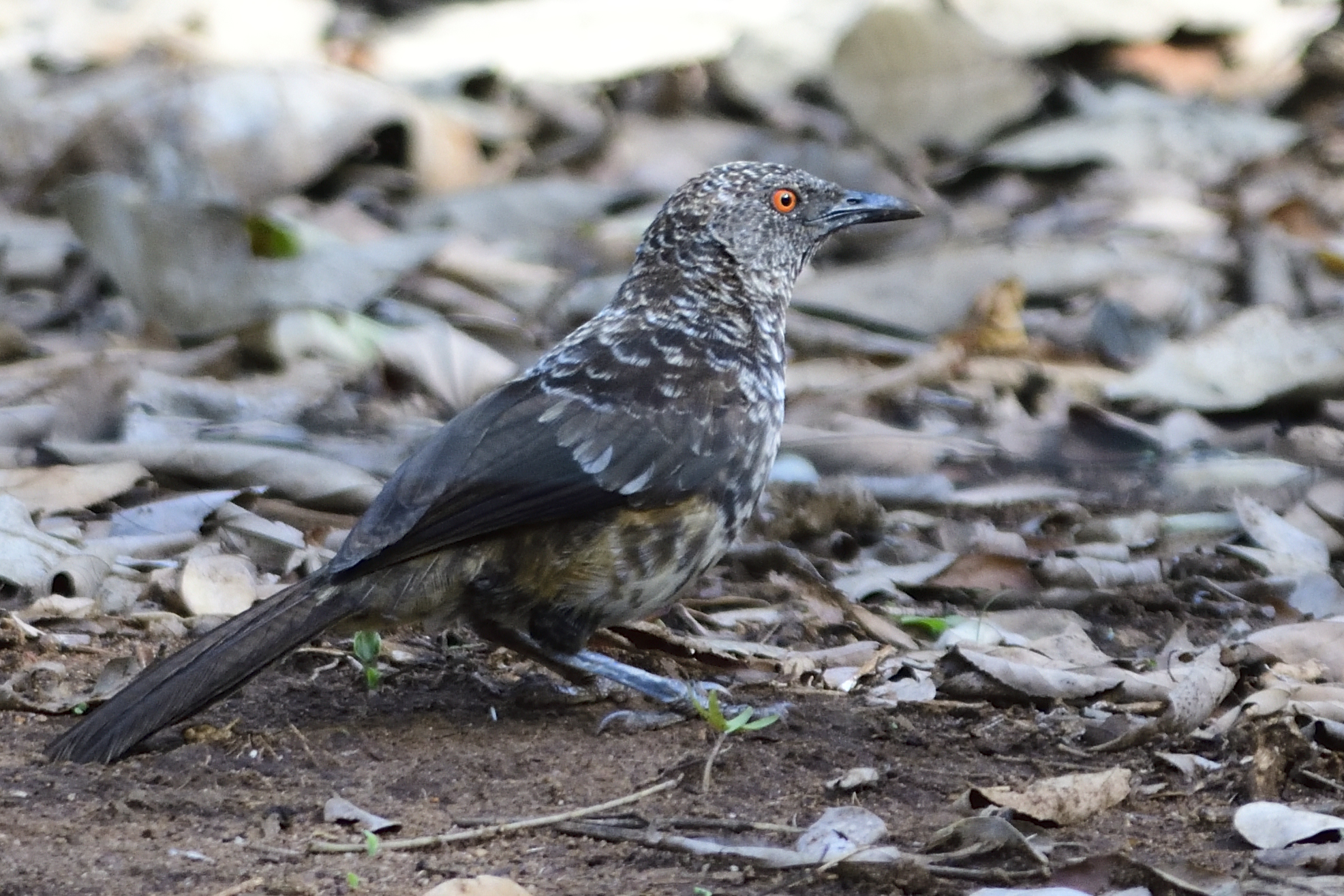
Hinde´s Babbler, Turdoides hindei – Endemic to Kenya
Day 17, Tuesday, October 8 – Castle forest Lodge
We were supposed to stay 3 nights in Castle Forest, but everything was depending on which birds we managed to see. We decided to just bird around the lodge in the morning before breakfast: Waller´s Starling, Scarce Swift, Slender-billed Greenbul, Brown Woodland Warbler, Abyssian Thrush, Baglafecht Weaver, Streaky Seed-eater, Tullberg´s Woodpecker, Brown-capped Weaver, Hunter´s Sunbird, Rüppel´s Robin-Chat, Thick-billed Seed-eater, Kikuyu White-eye, Grey Apalis, Kandt´s Waxbill, White-bellied Tit, Northern Double-collared Sunbird, Mountain Buzzard, Yellow-whiskered Greenbul, White-eyed Slaty Flycatcher, Reichenow´s Seed-eater, Crowned Eagle, Hartlaub´s Turaco, Abbot´s Starling, Black-throated Wattle-eye, Martial Eagle, Eastern Double-collared Sunbird and Chestnut-throated Apalis were some of the birds we picked up before breakfast. We had breakfast and wasted no time going out birding again. We took Lizzie and started driving downhill stopping at strategic places walking from the car checking for birds. We added the following species: Cinnamon-chested Bee-eater, Grey Cuckooshrike, Black-throated Apalis and Olive-breasted Mountain Greenbul. We kept on going for a while, but could not locate any more new species, so we went back to the lodge for lunch. After lunch, we continued and added: Eastern Bronze-naped Pigeon, Tambourine Dove, Mountain Oriole, Bar-tailed Trogon, Red-capped Robin-Chat, and White-headed Wood Hoopoe. We set down at the lodge to wait for Olive Ibis to make a fly by, but it never appeared, instead we had a couple of Red-fronted Parrot´s fly by before dark. We celebrated that Sybrand had ticked his bird number 1300 for his African list that day with a bottle of bubbly. During dinner that night we made our plans. We had cleaned up pretty much the first day and decided to leave the morning after. Samburu and Buffalo Springs were not in my original plans, but I suggested we made a little detour because there were several species that Sybrand needed there. It was not hard to convince Sybrand 🙂
Some pictures from day 17:

Chestnut-throated Apalis, Apalis porphyrolaema – Endemic to East Africa

Grey Apalis, Apalis cinerea

Hunter´s Cisticola, Cistecola hunteri – Endemic to East Africa

Streaky Seed-eater, Crithagra striolata

Thick-billed Seed-eater, Chrihagra burtoni

Abbott´s Starling, Pholia femoralis – Endemic to East Africa – Lifer

Tacazze Sunbird, Nectarina tacazze – Endemic to NE Africa

White-bellied Tit, Parus albiventris

Bar-tailed Trogon, Apaloderma vittatum

Kandt´s Waxbill, Estrilda kandti

Tullberg´s Woodpecker, Campethera tullbergi

Selvine is enjoying the local avifauna from Castle Forest Lodge.
Day 18, Wednesday, October 9 – Castle Forest Lodge to Samburu
We packed camp in the morning and birded our way down to the main road. We only managed to add Scaly Spurfowl to the list for Castle Forest. We were soon on our way to Samburu. At the crossing of Equator, we took the necessarry picture and picked up 2 new birds for the trip: Speke´s Weaver and Cape Crow. We continued and arrived at Archer´s Gate gate at around 13.30 and had quite a few hours for birding before we would reach the campsite by the river. Before the gate, we checked all the House Sparrows to see if we could find a Somali Sparrow, but after a while, the locals got very upset at us so we had to abandon that plan. At the gate we had Eastern Yellow-billed Hornbill, Fan-tailed Raven and Black-cheeked Waxbill. We started driving in to the park, it was still hot so the bird activity were slow. After a while we started picking up species: Pygmy Batis, Abyssinian Scimitarbill, Black-throated Barbet, Northern Puffback, Black-capped Social Weaver, Yellow-necked Spurfowl, Pygmy Falcon, Donaldson Smith´s Sparrow-Weaver, Taita Fiscal, Rosy-patched Bushshrike, Vulturine Guineafowl, Parrot-billed Sparrow and Foxy Lark. We took off from the main road heading for the mountain range where we found a special bird last time. We added Abdim´s Stork, Buff-crested Bustard, Yellow-spotted Petronia Chestnut Weaver and Somali Bunting before Francis´s sharpe eyes picked up our target bird: Somali Bee-eater. Having boxed that, we continued towards camp. It was still not 16:00 yet so we birded on the way. Martial Eagle, White-headed Mousebird, Rufous Chatterer, Nubian Woodpecker, Grey Wren-Warbler and Fischer´s Starling were added. We reached the camp ground by the river and Selvine cooked us a delicious meal. We had a camp fire going, but soon retired to bed.
Some pictures from Day 18:
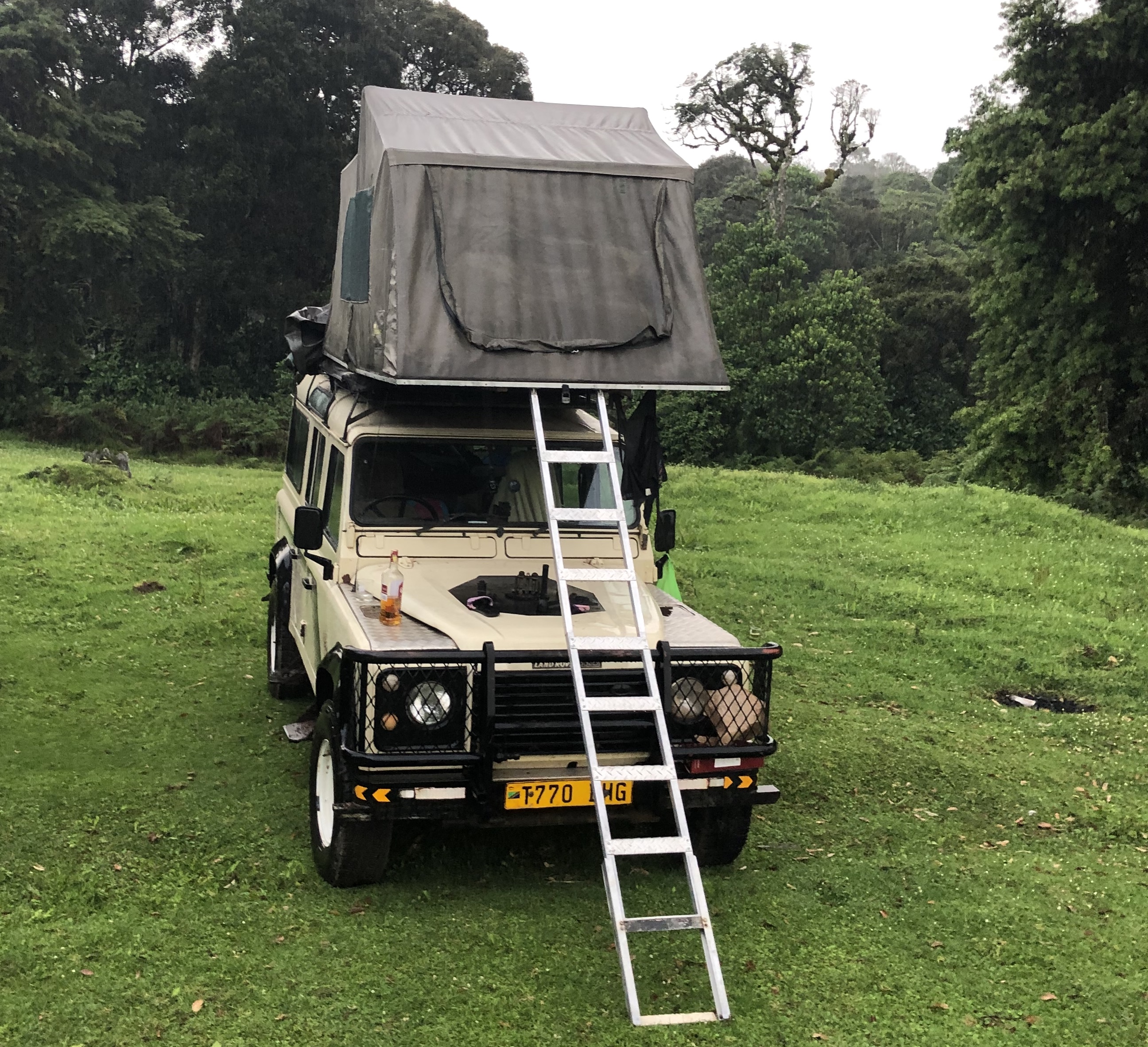
Lizzie early morning at Castle Forest Lodge

Eastern Yellow-billed – Hornbill, Tockus flavirostris – Endemic to NE Africa

Lizzie crossing Equator at Nanyuki, Kenya

Foxy Lark, Calendulauda alopex – Endemic to NE Africa

Vulturine Guineafowl, Acryllum vulturinum

Crested Francolin, Dendoperdix sephaena

Black-capped Social Weaver, Pseudonigrita cabanisi – Endemic to NE Africa

Donaldson Smith´s Sparrow-Weaver, Plocepasser donaldsoni – Endemic to NE Africa

Somali Bee-eater, Merops revoilii – Endemic to East Africa

Rufous Chatterer, Turdoides rubiginosa – Endemic to NE Africa

White-headed Mousebird, Colius leucocephalus – Endemic to NE Africa

Nubian Woodpecker, Campethera nubica – Endemic to NE Africa
Day 19, Thursday, October 10 – Samburu, via Buffalo springs to Naro moru
We packed camp in the morning. While packing I heard loud noises from some birds. We had a group of Grant´s Wood Hoopoes (Picture lifer) in camp. I saw one there last time I was there, but no pictures. This time however, they were posing willingly. We crossed the river and drove in to Buffalo Springs. We were heading for the natural spring and picked up Bateleur, Black-faced and Chestnut-bellied Sandgrouse, Red-winged Lark and a Gabar Goshawk. At the springs, Selvine and I took a swim while Sybrand and Martin birded. They got Magpie Starling and a flock of flying Somali Coursers. We got in the car and started towards the gate, Isabelline Wheatear, Secretarybird, Red-winged Starling, Somali Ostrich, Northern Crombec, Martial Eagle, Parrot-billed Sparrows and at the gate a Fan-tailed Raven. We exited the park and just south of Isiolo, Francis had a place for Boran´s Cisticola. We dipped on this last time, but this time, we got some help from a friendly local farmer. We walked through his fields and up to real habitat. Francis had picked up the call from far away. we positioned ourself and played the call and out popped a Boran Cisticola. My second lifer on the trip. We started driving towards Naro Moru and arrived there in a terrible rain storm. We managed to see Bronzy Sunbird when the rain stopped for a second. We were supposed to camp there, but in the end I got us rooms instead, it would have been a very wet night in the rain. We had dinner and retired to bed.
Some pictures from day 19

Grant´s Wood-Hoopoe, Phoeniculus granti – Endemic to East Africa – Photo Lifer
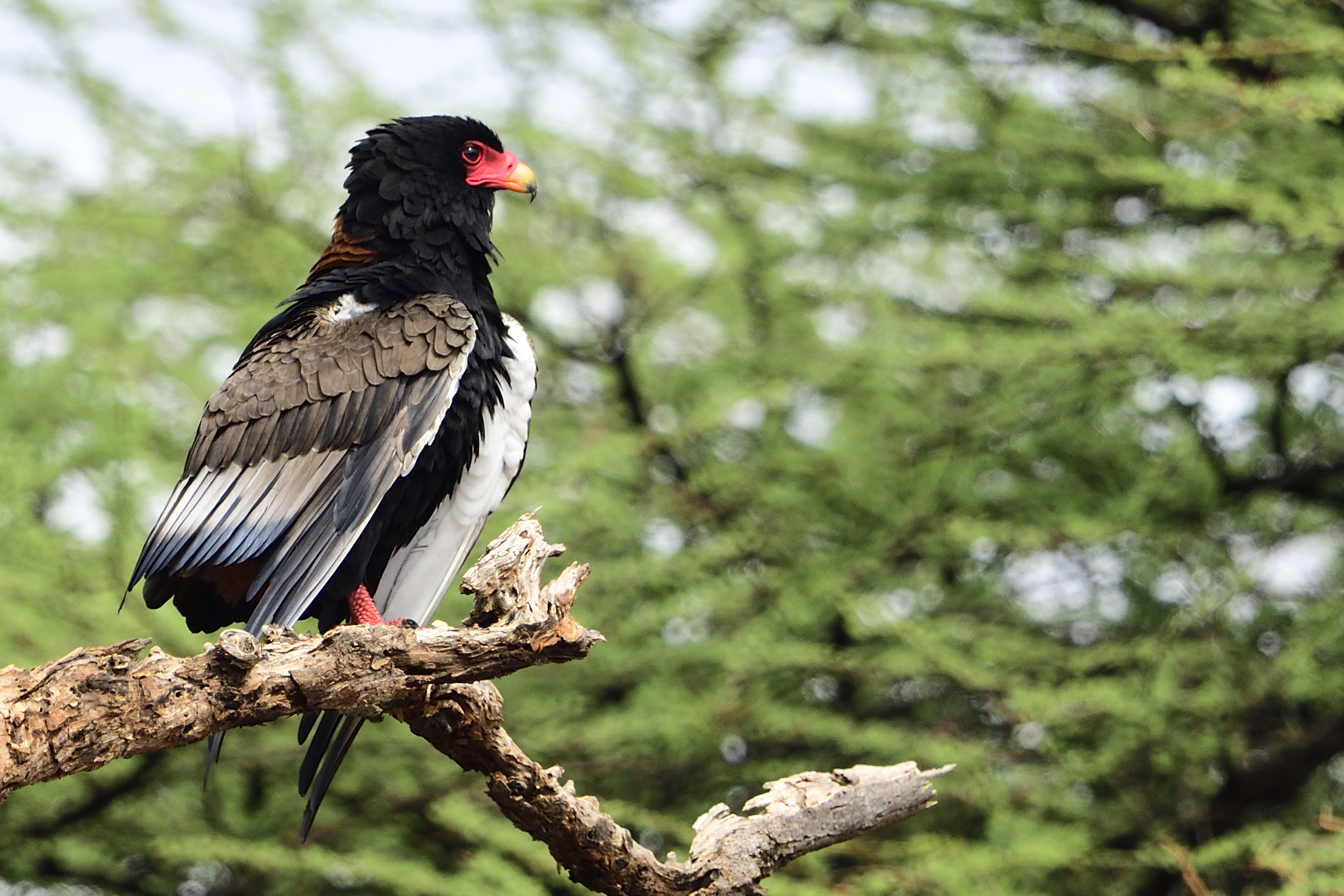
Bateleur, Terathpius ecaudatus

Isabelline Wheatear, Oenanthe isabellina

Gabar Goshawk, Micronsius gabar

Martial Eagle, Polemaetus bellicosus

Parrot-billed Sparrow, Passer gongonensis – Endemic to NE Africa

Fan-tailed Raven, Corvus rhipidurus

Boran Cisticola, Cisticola bodessa – Endemic to NE Africa – Lifer
Day 20, Friday, October 11, 2019 – Naru Moro to Lake Baringo
We birded the garden of Naru Moro lodge this morning: Grey-capped Warbler, Cut-throat Finch a flock of over flying Red-fronted Parrots (No pictures), Tacazze Sunbird, Mountain Wagtail, White-eyed Slaty Flycatcher, Rüppel´s Robin-Chat and Kenya Rufous Sparrow was the most interesting birds we saw. We had breakfast and set out for Lake Baringo. We choose some dirt roads so we could do some birding on the way. Here are some of the birds we saw before we hit the main road: Grey-crowned Crane, Black-winged Lapwing, Anteater Chat, Northern Wheatear, Rufous-naped Lark (No idea what race), Isabelline Wheatear, Plain-backed Pipit, Pectoral-patched Cisticola (heard only), Yellow Wagtail (first of the season), D`Arnaud´s and Red-fronted Barbet and Greater Blue-eared Starling. We hit the main road and Francis called the local guide that looks after the Mackinder´s Eagle-Owl. We were soon at the spot and had very nice views of the Owl. We only stopped for about half an hour and pushed on. Just before Thompson´s Fall´s we tried the shortcut marked by Google Maps. The road was bad, but at a building Francis shouted Fischer´s Lovebird. I backed Lizzie and sure a colony of the Lovebirds were hanging out there. This was a very unexpected bonus bird for Sybrand. On the same dirt road, we came across some fantastic wetlands. They were quite far from the road we were on and we did not have time to explore. From the car we saw a huge number of water birds, but they were too far away. This area needs to be explored on a later opportunity. I estimate that the wetland was about 15km before you reach Marigat on road C51. We hit the tar again at Marigat and from there it was a straight run to Robert´s Camp on Lake Baringo. We arrived at around 16:30 and quickly set up camp and did some lazy birding from the restaurant at Robert´s Camp: Rüppel´s Starling, Northern Masked Weaver, Dusky Turtle Dove, Woodland Kingfisher, Pearl-spotted Owlet, Goliath Heron, Striated Heron and Bristle-crowned Starling was all found in camp. Francis lives around Lake Baringo, so he wanted to go home and visit his family. We had a nice dinner and retired early to bed.
Some pictures from Day 20:

Mountain Wagtail, Motacilla clara

White-eyed Slaty Flycatcher, Dioptrornis fischeri – Endemic to Central and East Africa

Plain-backed Pipit, Anthus leucophrys

Mackinder´s (Cape) Eagle-Owl, Bubo Mackinderi

Goliath Heron, Ardea goliath

Bristle-crowned Starling, Onychognathus salvadorii – Endemic to NE Africa
Day 21, Saturday, October 12, 2019 – Lake Baringo
We had a full day in Lake Baringo and Francis came to camp at 07:00. We were going to bird below the rock wall this morning. A very special place. On the rode we saw a Common Ostrich. Once we parked the car, we started picking up species rapidly: Verreaux´s Eagle, Jackson´s Hornbill, Hemprich´s Hornbill, Mocking Cliff Chat, Beautiful Sunbird, Eastern Violet-backed Sunbird, Acacia Tit, Brown-tailed Rock Chat, Mouse-coloured Penduline Tit, Hunter´s Sunbird, Pink-breasted Lark and Grey Wren-Warbler. Almost all our targets in box. We crossed the main road for some other birds: Pale Prinia, Fan-tailed Raven, Green-winged Pyttilia, Northern Crombec, Harlequin Quail, Little Weaver + many more. We returned for lunch and Francis took his piky piky (Motor cycle) to find the day roost for some of the special nocturnal birds of Lake Baringo. We relaxed in camp and did a small walk in camp. Spotted Palm Thrush, Spur-winged Lapwing, Northern Red-billed Hornbill and Beautiful Sunbirds were seen. Francis came to pick us up at 15:00 and had his plan ready. First he took us to a dry river bed where he gave us Northern White-faced Owl, Then to a football pitch for a Three-banded Courser, just across the road a Slender-tailed Nightjar. The last spot was a little further for the Greyish Eagle-Owl. We also picked up Magpie Starling and Pygmy Batis at the owl spot. We were running out of target species. The one missing was the Three-streaked Tchagra. Francis had another road a little further from Lake Baringo, we went there and picked up many species until we finally found the Tchagra. Other species included Pygmy Falcon, Red-and-yellow Barbet, Long-tailed Paradise Whydah, Chestnut Sparrow, Jacobin Cuckoo, Gabar Goshawk and Dark Chanting Goshawk. We returned to camp. Our plan was to stay 3 nights at Robert´s Camp, but with all the target species in box, we decided to leave the day after. I believe Sybrand was a happy camper when he went to bed that night.
Some pictures from Day 21:

Jackson´s Hornbill, Tockus jacksoni – Localised endemic to East Africa

Brown-tailed Rock-Chat, Cercomela scotocerca

Acacia Tit, Parus thruppi – Endemic to NE Africa

Eastern Violet-backed Sunbird, Anthreptes orientalis – Endemic to NE Africa
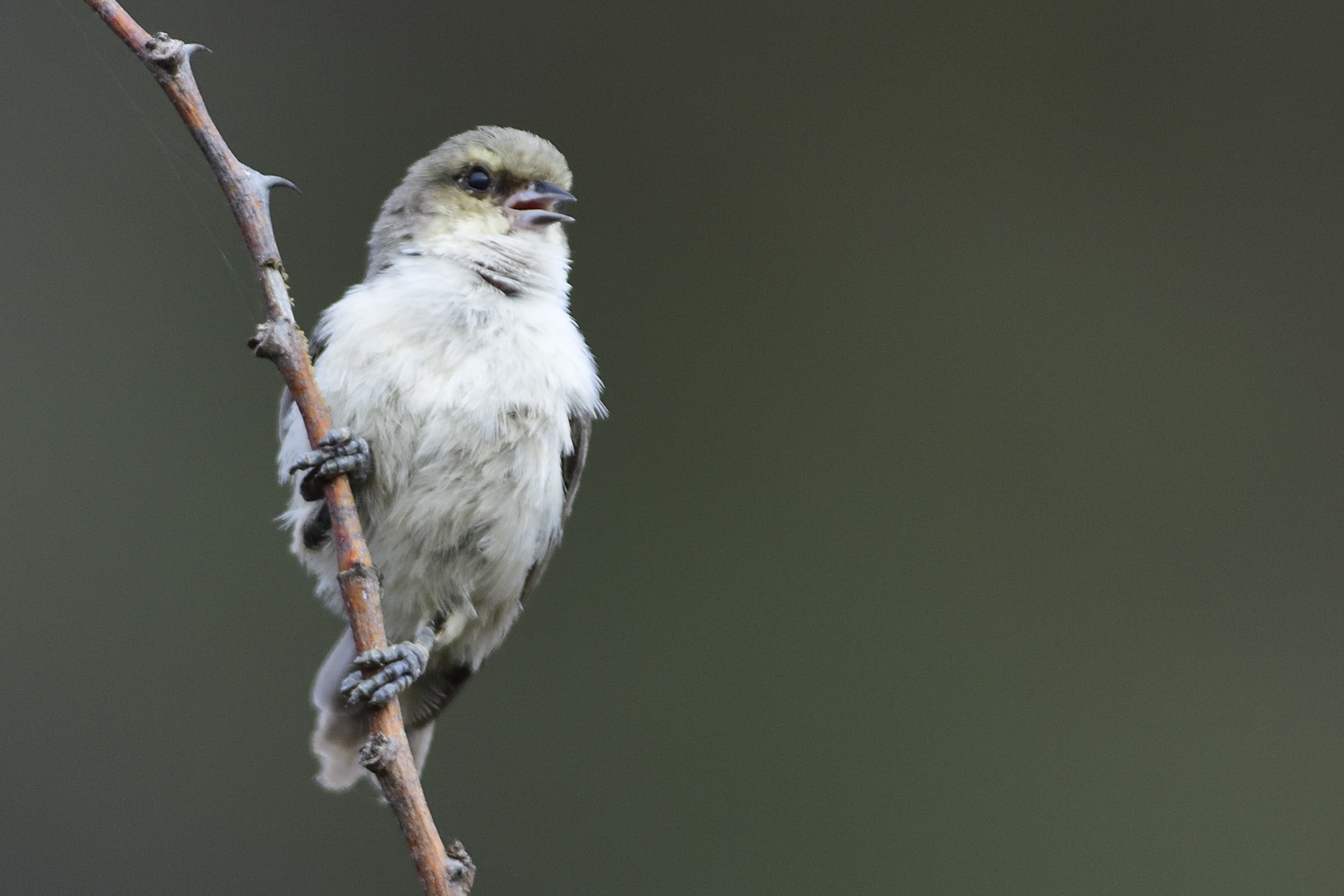
Mouse-coloured Penduline-Tit, Anthoscopus musculus – Endemic to NE Africa

Green-winged Pyttilia, Pytilia melba

Northern Red-billed Hornbill, Tockus erythrorhyncus

Beautiful Sunbird, Cinnyris pulchellus
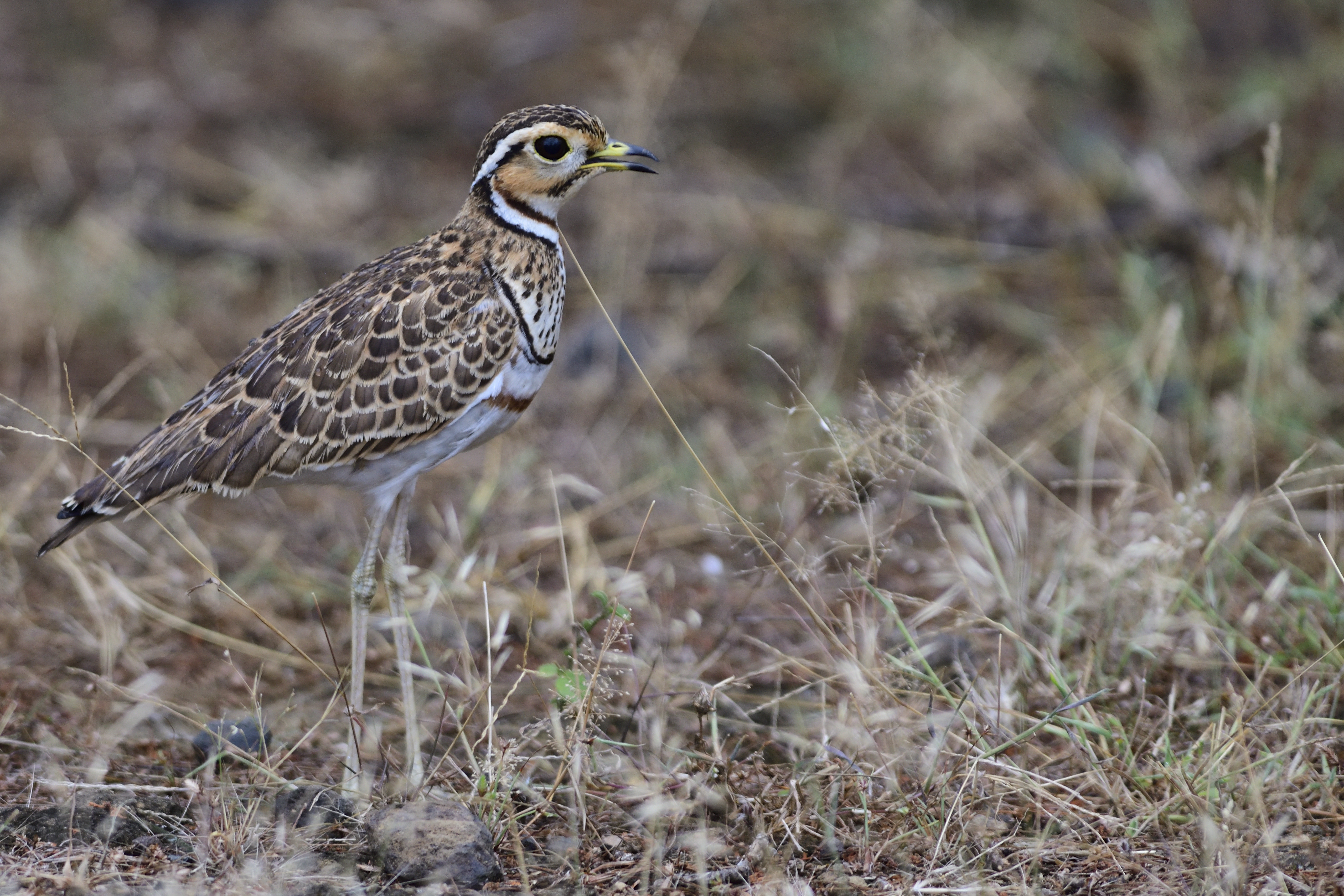
Three-banded Courser, Rhinoptilus cinctus

Greyish Eagle-Owl, Bubo cinerascens
Day 22, Sunday, October 13 – Lake Baringo to Kakamega Forest.
The night before Sybrand and I had gone through his list and looked what we were missing. We realized that we had dipped on the Straw-tailed Whydah in Tanzania. I knew it also occured around Lake Baringo, so we put the challenge to Francis in the morning. He knew a spot and we set out. I got better pictures of a Pale Prinia on the way and at a small lake sure enough we had an overflying Straw-tailed Whydah and after some search, we found it perched. The last target for Sybrand was the White-billed Buffalo Weaver. Last time we had to go all the way to Lake Bogoria to get that bird, but now Francis had a breeding colony in a tree inside a local school close to Marigat. We could see the bird from the road, but distant views. I asked Francis if we could go inside the school yard. He said no. I said, have you asked? he said no. I said the worst answer you can get is a no, so please go and ask? He reluctantly went and we were granted permission. We got good views of the bird and afterwords were invited by the nun headmaster to her office. She was very friendly and very happy to have to Wazungu (white men) on her premises. We were soon on our way again. there is a very steep climb up to the town of Kabarnet. Last time I had severe heating problems with Lizzie, but this time everything went smooth. We stocked up on supplies in Cabarnet and were soon on our way downhill towards the Kerio River Valley. The valley is known to have Chestnut-crowned Sparrow-Weaver, a bird both Sybrand and I needed, so we drove very slowly through the valley, but no luck spotting the bird from the car. We started the ascent on the western wall of the rift valley. We have a spot there for the White-crested Turaco, but Sybrand already had that bird from Uganda so we pushed on to the top and had a small break at the viewing point there. We passed the town of Eldoret and Sybrand could tell an interesting story about Boers from South Africa tired of the English came there to settle. We were running a bit late and continued to our camping site. The place also has rooms, so I enquired about the cost of the rooms with full board and the price were more than acceptable, so in stead of camping we got a room each. We took a bird walk around 16:30 and started picking up new species: Brown-throated Wattle-eye, African Shrike-Flycatcher, Petit´s Cuckooshrike, Black-necked Weaver, Yellow-throated Leaflove, Red-headed Bluebill, African Blue Flycatcher, Grey-headed Nigrita, Black-and white Casqued Hornbill, Turner´s Eremomela, Joyful Greenbul, Northern Black Flycatcher and finally a White-tailed Ant-Thrush (Picture lifer for me). The light was bad, but at least I managed some record shots.We returned happily to camp, had dinner and retired for the night.
Some pictures from Day 22:

Pale Prinia, Prinia somalica – Endemic to NE Africa

Selvine and me enjoying the view from the top of the Wstern Wall of The Great Rift Valley enroute to Kakamega Forest.

White-tailed Ant-Thrush, Neocossyphus poensis – Photo Lifer
Day 23, Monday, October 14 – Kakamega Forest.
We had a full day in Kakamega today. We were going to the entrance of the forest today were a little stream crosses the road. There is a path up there and because all the locals walking up and down that road, the birds are not too shy. On the way, we heard Scaly-breasted Illadopsis and saw Cinnamon-chested Bee-eater. We parked Lizzie and started walking up the path: Mountain Wagtail, Joyful Greenbul, Grey Wagtail (many of them throughout our stay), Yellow-spotted Barbet, Grey Apalis, Uganda Woodland Warbler, Brown-chested Alethe, Yellow-billed Barbet, Red-tailed Bristlebill, Slender-billed Greenbul, Bocage´s Bushshrike, Lühder´s Bushshrike, Northern Double-collared Sunbird, White-chinned Prinia, Ansorge´s Greenbul, Kakamega Greenbul and Brown-capped Weaver. Quite a list for 2 hours birding? We were back at Lizzie and decided to stop at Rondo retreat to bird the garden and some of the paths around the retreat. Vieillot´s Black Weaver, Mackinnon´s Shrike, Black-faced Prinia, Chubb´s Cisticola, White-spotted Flufftail, Black-collared Apalis, Grey-throated Barbet, Stuhlmann´s Starling, Snowy-crowned Robin-Chat, Jameson´s Wattle-eye, Black-billed Weaver, Crowned Eagle, Green-headed Sunbird and White-headed Saw-wing + many more were seen. We had a drink in the garden and then went back to camp for lunch. After lunch, we did another walk, but rain stopped us. We only added African Thrush and Dark-backed Weaver to our list. What a fantastic day birding. Kakamega was delivering. We all went to bed that night with a smile on our faces.
Some pictures from Day 23:
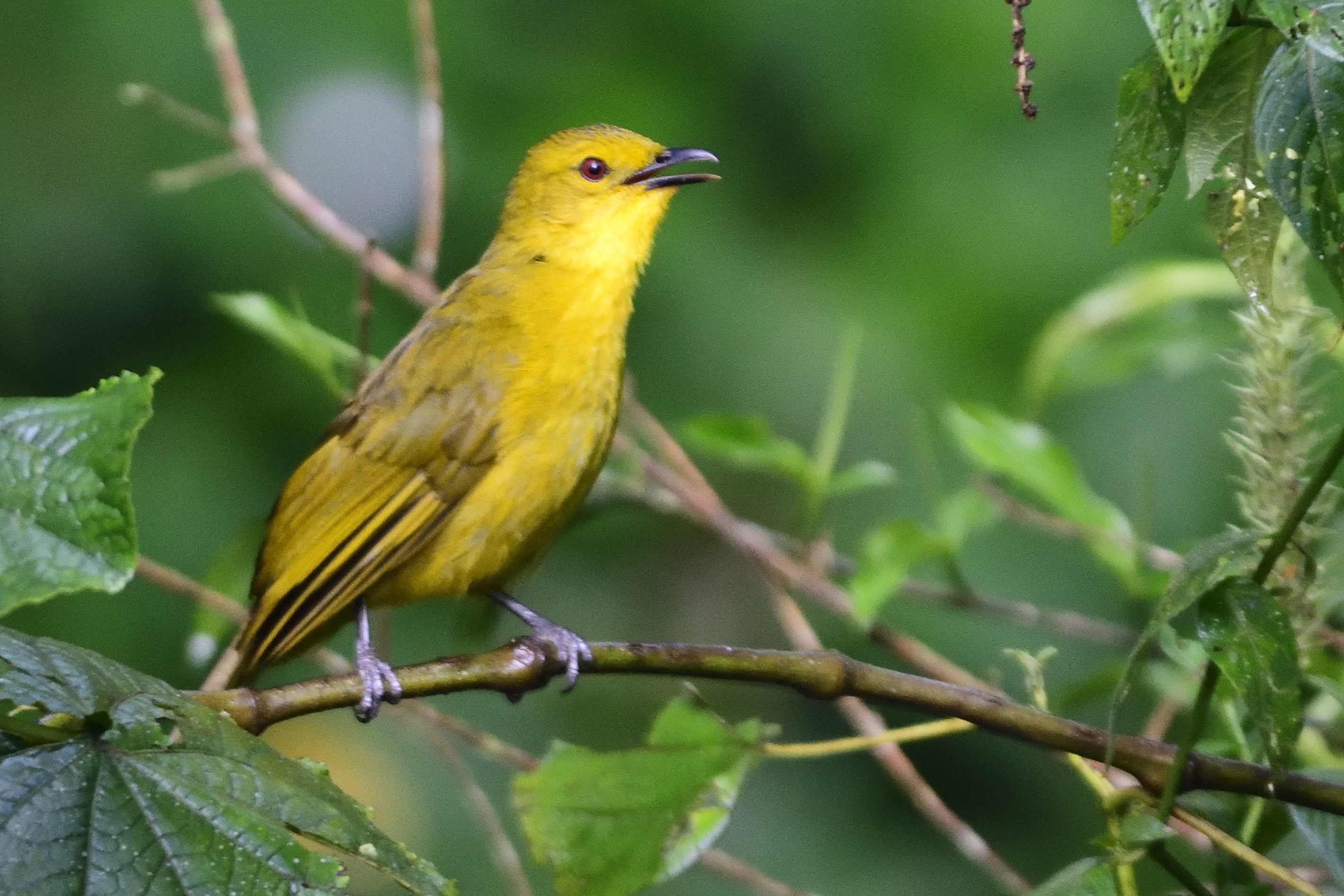
Jouful Greenbul, Clorocichla laetissima – Endemic to East Africa

Slender-billed Greenbul, Stelgidillas gracilirostris

Grey Wagtail, Motacilla cinerea

Bocage´s Bushshrike, Chlorophoneus bocagei

Turner´s Eremomela, Eremomela turneri – Endemic to Kakamega and a forest in East DRC

Mackinnon´s Fiscal, Lanius mackinnoni

Grey-throated Barbet, Gymnobucco bonaparte

Black-collared Apalis, Orealis, pulchra

White-chinned Prinia, Schistolais leucopogon
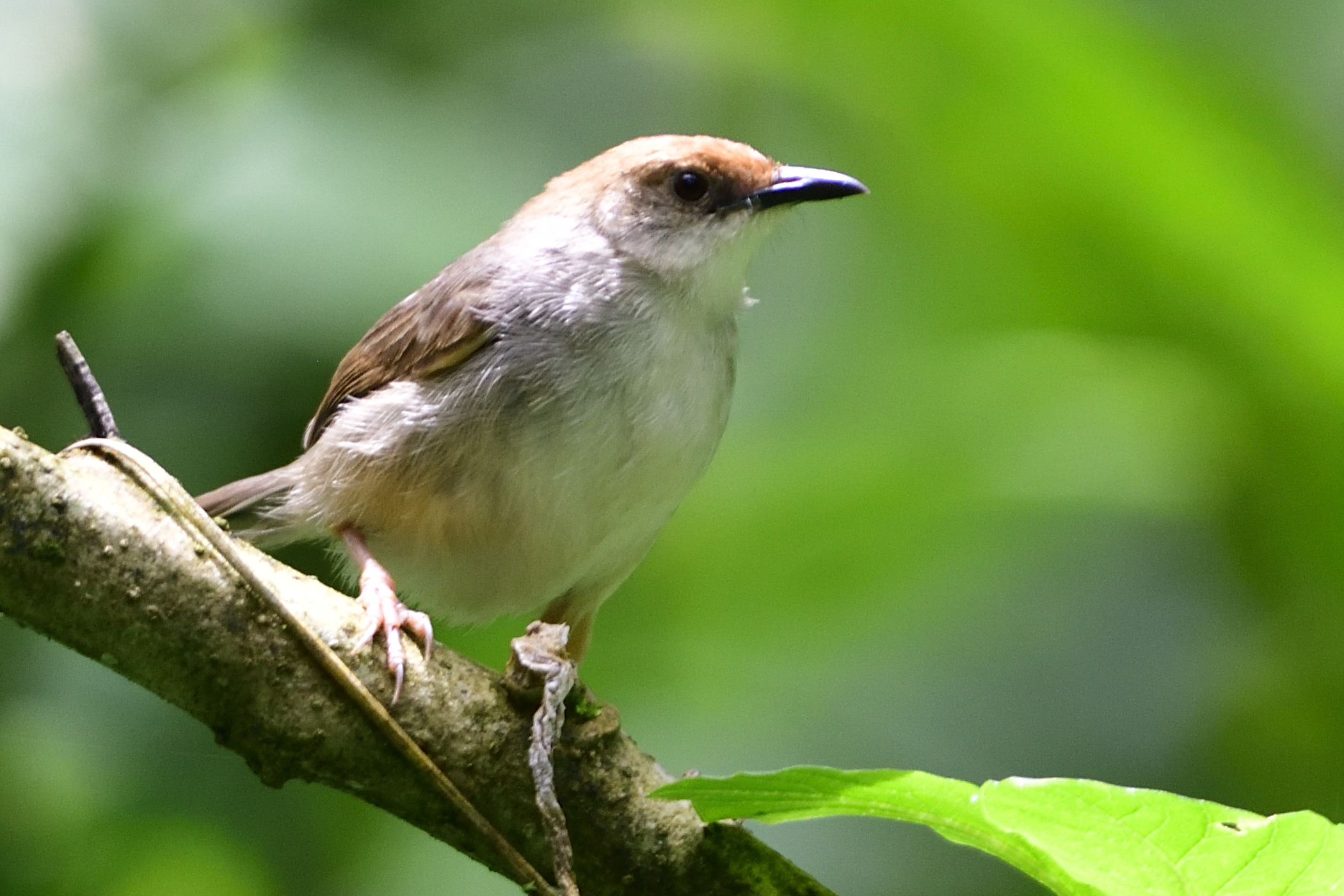
Chubb´s Cisticola, Cisticola chubbi

Jameson´s Wattle-eye, Platysteira jamesoni – Endemic to EC Africa
Day 24, Tuesday, October 15 – Kakamega Forest
We started the morning on the same path as yesterday. It was a lot of traffic that day, so the birds were disturbed. We managed to find a Sharpe´s Drongo (Split from Square-tailed Drongo), Red-tailed Bristlebill and a Pink-footed Puffback. Not many other birds to be seen. We went back to Lizzie and drove a little towards the Rondo retreat. We found another path where we found a pair of Black-faced Rufous Warblers. We walked on and found a Brown-chested Alethe in the middle of the road. Later on, Western Oriole and Bar-tailed Trogon. Francis and Sybrand walked off, while I went back to take pictures of the Rufous-Warblers. They came back and had found two more target species, Equatorial Akalat and Blue-shouldered Robin-Chat. We saw another Grey Wagtail with different coloration than the one from the day before. Last bird before lunch was a Olive-green Camaroptera. After lunch we went back to Rondo retreat to explore more: Yellow-crested Woodpecker, Cabanis´s Greenbul, Northern Black Flycatcher, Double-toothed Barbet and Green-throated Sunbird were added. We were stopped by rain and retired to our lodge. We still missed some birds and asked Francis to contact the local guide Winston to do half a day birding with us on the last day.
Some pictures from Day 24

Red-tailed Bristlebill, Bleda syndactylus

Sharpe´s Drongo, Dicrurus sharpei – Lifer
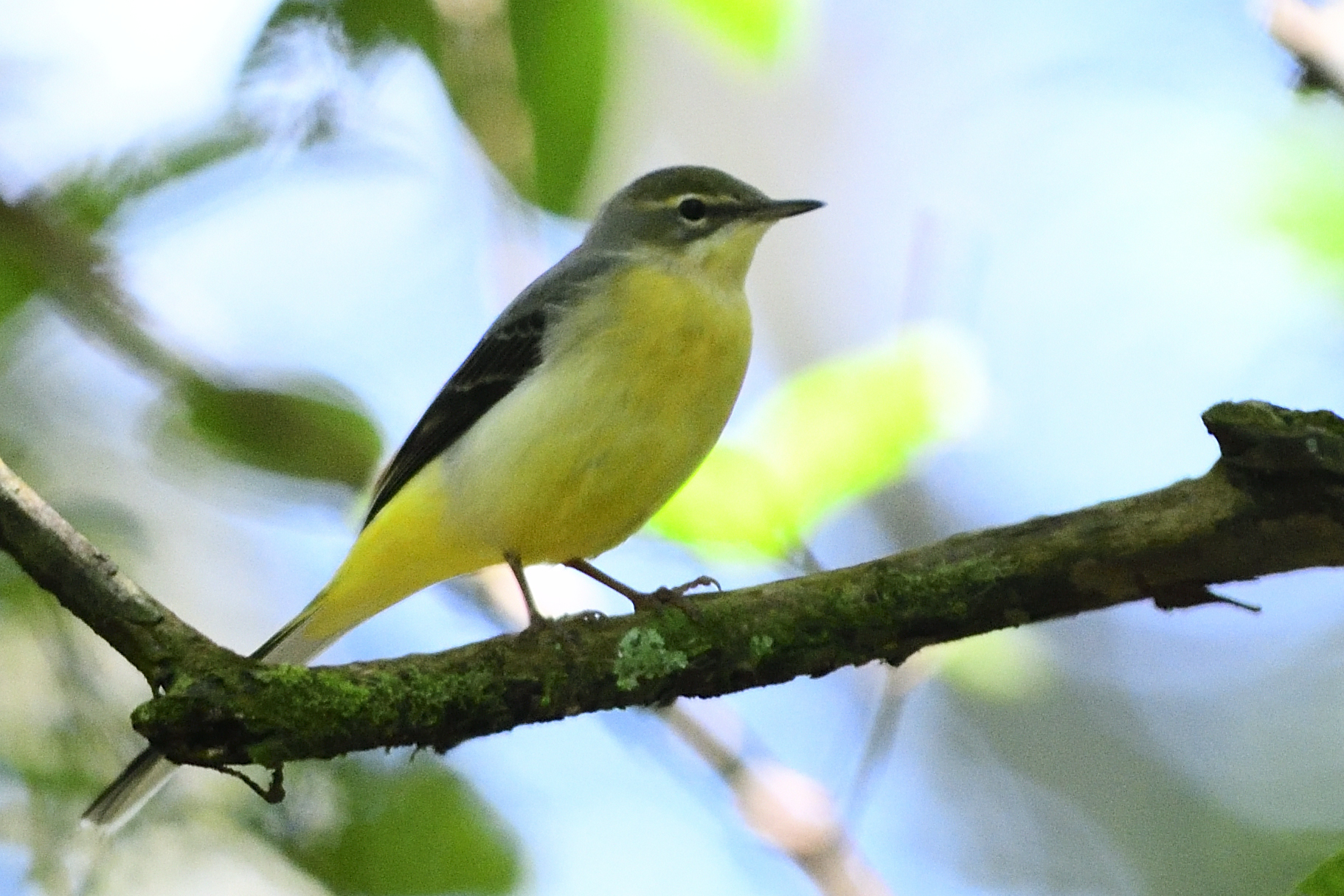
Grey Wagtail, Motacilla cinerea

Black-faced Rufous Warbler, Bathmorcercus rufus (Male)

Black-faced Rufous Warbler, Bathmorcercus rufus (Female)
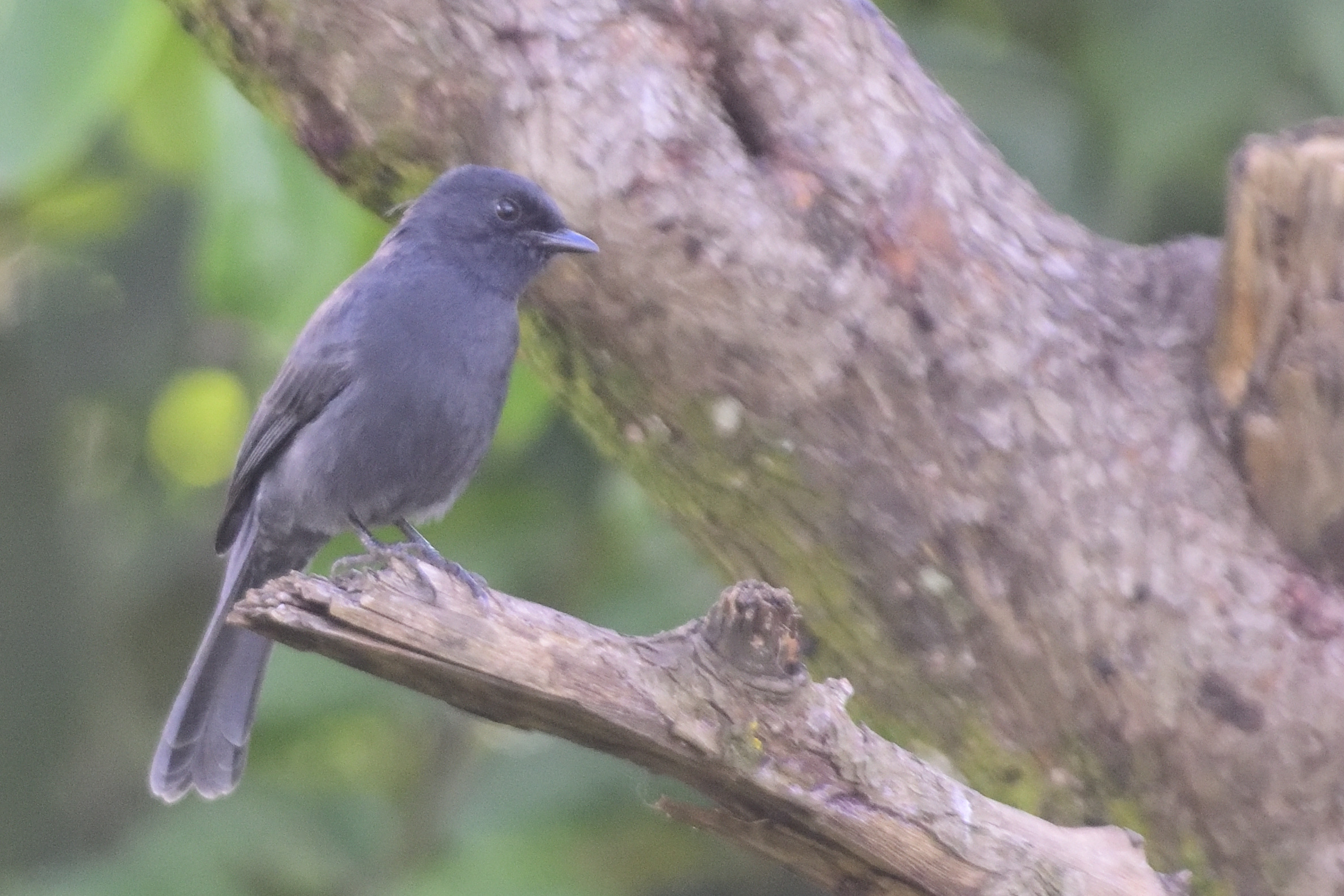
Northern Black Flycatcher, Melaenornis edolioides
Day 25, Wednesday, October 16 – Kakamega Forest to Kisumu
We met up with the local guide Winston at Rondo retreat in the morning. We walked a few new paths around the retreat and picked up a pair of Petit´s Cuckooshrike, Green-headed Sunbird, Buff-throated Apalis and Brown-eared Woodpecker. He then took us yo the river trail and we found quickly one of our targets, Dusky Tit. After another 20 minutes we got our main target for the day, Blue-headed Bee-eater. On the way back to Rondo retreat, we also got a Thick-billed Honeyguide. We went back to camp, had breakfast and packed Lizzie. We were soon on our way to Kisumu. At Kisumu, we stopped at Hippo point and did some birding: Brown-backed Honeybird, Red-chested Sunbird, Swamp Flycatcher, Greater Swamp Warbler, African Thrush and Reichenow´s Seed-eater were some of the birds we found. Lizzie took us to Dunga Hill Camp, where we were camping for the night. We quickly set up camp and was entertained by a Broad-billed Roller. We took a little walk along the reeds and got Black-headed Gonolek, White-throated Bee-eater, Winding Cisticola, Slender-billed Weaver, Blue-headed Coucal and Carruther´s Cisticola (Picture Lifer). We heard several White-winged Swamp Warblers, but could not lure them to come out. I have been looking for this bird so many times, but it always eludes me. The rain started coming down, so we went back to camp and had dinner in the restaurant. We had an early night. Selvine had caught a stomach bug a few days before and was getting worse and worse 🙁
Some pictures from Day 25:

Petit´s Cuckooshrike (female), Campephaga petiti

Dusky Tit, Parus funereus

Uganda Woodland Warbler, Phylloscopus budongoensis

Greater Swamp Warbler Acrocephalus rufescens

Broad-billed Roller, Eurystomus glaucurus

Carruther´s Cisticola, Cisticola carruthersi – Endemic to East Africa
Day 26, Thursday, October 17 – Kisumu to Lake Naivasha
We had booked a boat ride this morning and we were picked up from camp at 07:00. Last time I had two boat rides, but they did not produce much in terms of special birds. This time was no exception. Meyer´s Parrot, Black Crake, Little Bittern, Purple Heron, Northern Brown-throated, Black-headed and Slender-billed Weavers, Lesser Swamp Warbler, Little Rush Warbler, and African Citril were the only good birds we saw. We returned to camp packed and headed off. We drove all the way to Lake Naivasha and arrived there around 17:00. We had a quick look at the lake and picked up Pink-backed and Great Pelicans.
Day 27, Friday, October 18 – Lake Naivasha to the foot of Aberdere National Park via Konangop plateau
We went down to the lake again this morning and picked up some more birds: Gull-billed Tern, Great Cormorant, Arrow-marked Babbler, Marabou Stork and Mountain Grey Woodpecker. We got Francis to get a local guide for us on this day too. His name was John Gitiri and he really new his patch. First target was Stout Cisticola (Picture lifer for me) which he found very easily. When we came back to the car, we could all see that Selvine was really sick. We drove to another spot which were supposed to hold a bird I dipped at last time, Sharpe´s Longclaw. When we arrived at the spot, the rain was really coming down, so we had to wait about an hour before it finally eased up a little. We started our walk and started picking up good birds: Golden-winged Sunbird, African Quailfinch, Kikuyu White-eye, Wing-snapping Cisticola, Long-tailed Widowbird, African Citril before we flushed the first two Sharpe´s Longclaw. We saw where they landed and chased them around for a while until we finally got close enough to get some pictures. Having the main target bird in box, we started returning to the car. On the way back, we picked up, Yellow-crowned Canary, Common Quail, African Snipe and Levaillant Cisticola. The last two were East African lifers for me. The Levaillant´s which is very common in South Africa has a very limited distribution in East Africa. Our next target was Jackson´s Widowbird. John warned us that we were not likely to find them because they are seasonal migrants and had moved out of the area. We searched for about one hour and finally gave up. We returned John to the place where we picked him up and continued towards Aberdere National Park. I had found a camp on iOverlander the day before and we had booked us in there. I believe the camp was called Kipipiri or something like that. The host was very friendly. The cabins were very rustic, but the price was ok and it was still better than sleeping in the tent. It turned out to be quite cold at this altitude so we soon went to the main house were we were served an excellent dinner in front of the fireplace. I remembered the last time I went to Aberdere. Then we camped inside the park at 3.000m and we were freezing all the time. After dinner, we returned to our cabins and went to sleep.
Some pictures from day 27:

Great Cormorant, Phalacrocorax carvo

Marabous Stork, Leptophilos crumeniferus

Mountain Grey Woodpecker, Dendropicos spodocephalus – Endemic to NE Africa

Stout Cisticola, Cisticola robustus – Picture Lifer

Kikuyu White-eye, Zosterops Kikuyuensis – Endemic to Kenya

Wing-snapping Cisticola, Cisticola ayresii

African Citril, Chritagra citrineloides – Endemic to NE Africa
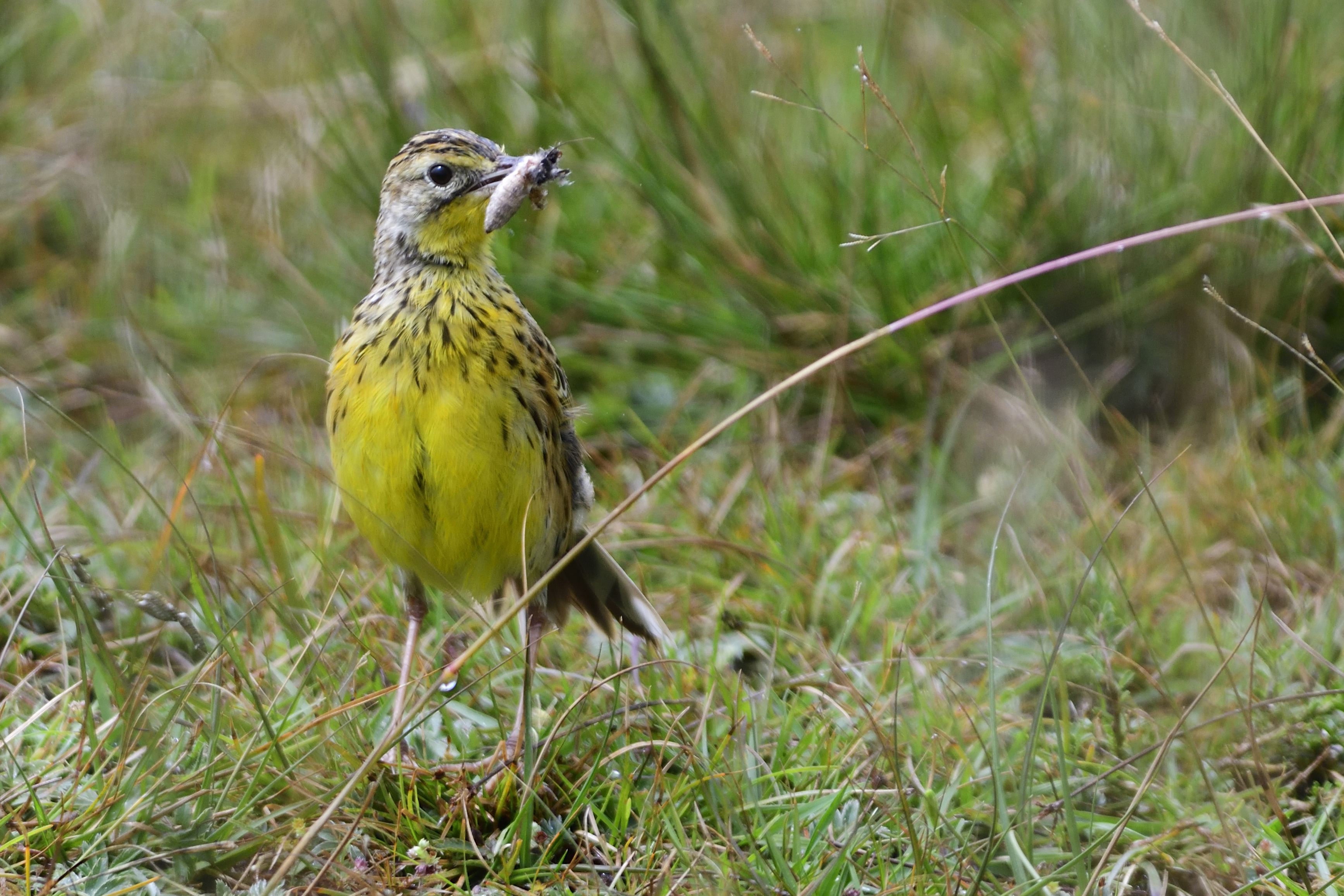
Sharpe´s Longclaw, Macronyx sharpei – Endemic to Kenyan highlands – Lifer

Levaillant´s Cisticola, Cisticola tinniens

Three happy campers after finding the Sharpe´s Longclaw. Me, Sybrand and John

Poor Selvine was cold and sick. It helped a little to warm her self by the fire
Day 28, Saturday, October 19 – Aberdere National Park to Voi.
We had almost 500km to travel today. Technically my trip with Sybrand would finish once we reached Nairobi, but we had been doing good on time, so Sybrand and me agreed to extend the trip to do Tsavo East, Watamu and Taita Hills. He had a target to reach and I had a competitive bug in me that wanted him to reach his target 🙂 My target was to get him to 1400 species before he left. That would mean adding 234 species to his list. We now felt we had a chance to do it. Unfortunately Selvine was feeling even worse this morning, so we left her behind when we left for Aberdere NP. We only had a handful of targets and started good when we picked up several Jackson´s Francolins on the way up the mountain. At the gate, we got Moorland Chat, Yellow-crowned Canary and a surprise bird, Slender-billed Starling. We were now just missing one target bird, the Aberdere Cisticola. I tried to negotiate with the rangers at the gate, but I still had to pay the full park fees. We went into the park and found a meadow after 5 minutes. Heard the Cisticola, played the call and it popped up nicely. We spent 5 minutes with the bird, then returned to the gate. All in all 15 minutes in the park. I tried to reason with the rangers, they said next time they make a deal with me. We drove slowly down the mountain and came to a very birdy area. The top birds were Golden-winged Sunbird, Mountain Yellow Warbler and Hartlaub´s Turaco. We continued down the hill. Had breakfast in camp. Picked up Selvine and continued down to the main road. Just before Nairobi, we stopped at a wetland where Francis meant we could find some nice ducks, but we only found normal waterbirds there, nothing exiting.We said our goodbyes to Francis and headed for Nairobi. Once in Nairobi, we dropped off Selvine. She had had a stomach bug for more than a week, so the safest was for her to go to a hospital. Sybrand and I continued to Voi and again iOverlander found us a nice camp with rustic cottages. We arrived just as it started to get dark. An hour later our new guide Willy Nganda arrived to camp. I had used Willy a few times before and he is a top guide. The hostess prepared a lovely dinner for us and we were soon in bed.
Some pictures from Day 29:

Jackson´s Spurfowl, Pternistis jacksoni – Endemic to East Africa

Moorland Chat, Pinarochra sordida – Endemic to NE Africa

Slender-billed Starling, Onychognathus tenuirostris

Aberdere Cisticola, Cisticola aberdere – Endemic to Central Kenya

Golden-winged Sunbird, Drepanorhynchus reichenowi – Endemic to East Africa
Day 29, October 20 – Voi to Watamu
We entered Tsavo East from the Voi gate and started looking for birds. The birding was extremly slow. We picked up just a few birds including Greater Honeyguide, Golden-breasted Starling, Singing Bush Lark, Fischer´s Starling, White-backed Vulture, White-bellied Bustard, Black-headed Lapwing, Bateleur and Somali Bee-eater. We entered the park at 07:00 and that was all we had to show for after more than 4 hours in the park. We had reached Aruba Lodge now and Willy wanted us to take a small detour. We went down a different road and saw quite a few Red-winged Larks, In addition Northern Wheatears, but the birding was still very slow. We returned to Aruba Lodge and continued on our way towards Watamu. Kori Bustard, African Harrier-Hawk, Pygmy Falcon, Somali Courser and Golden Pipit was picked up before we had nice views of a Cheetah. We finally came to the Eastern gate and had seen around 20 species in a full day in the park. Last time I was in the park, I must have had at least 100 species, not sure what happened that day. Anyway, we continued to Watamu and to our home for the night, the Mida Ecocamp. Again a rustic affair, but better than sleeping in a tent. The camp was located close to the sea and we wasted no time going down to find the tide were out. Sybrand needed some waterbirds amongst them Crab Plovers. Plenty of that species on display + Terek Sandpiper, Lesser Sand Plover, Grey Plover, Little Stint, Whimbrel, Curlew Sandpiper and Gull-billed Tern. We went back to the lodge, had our meal and retired to bed.
Some pictures from Day 29:

Red-winged Lark, Mirafra hypermetra – Endemic to NE Africa

Isabelline Wheatear, Oenanthe Isabellina
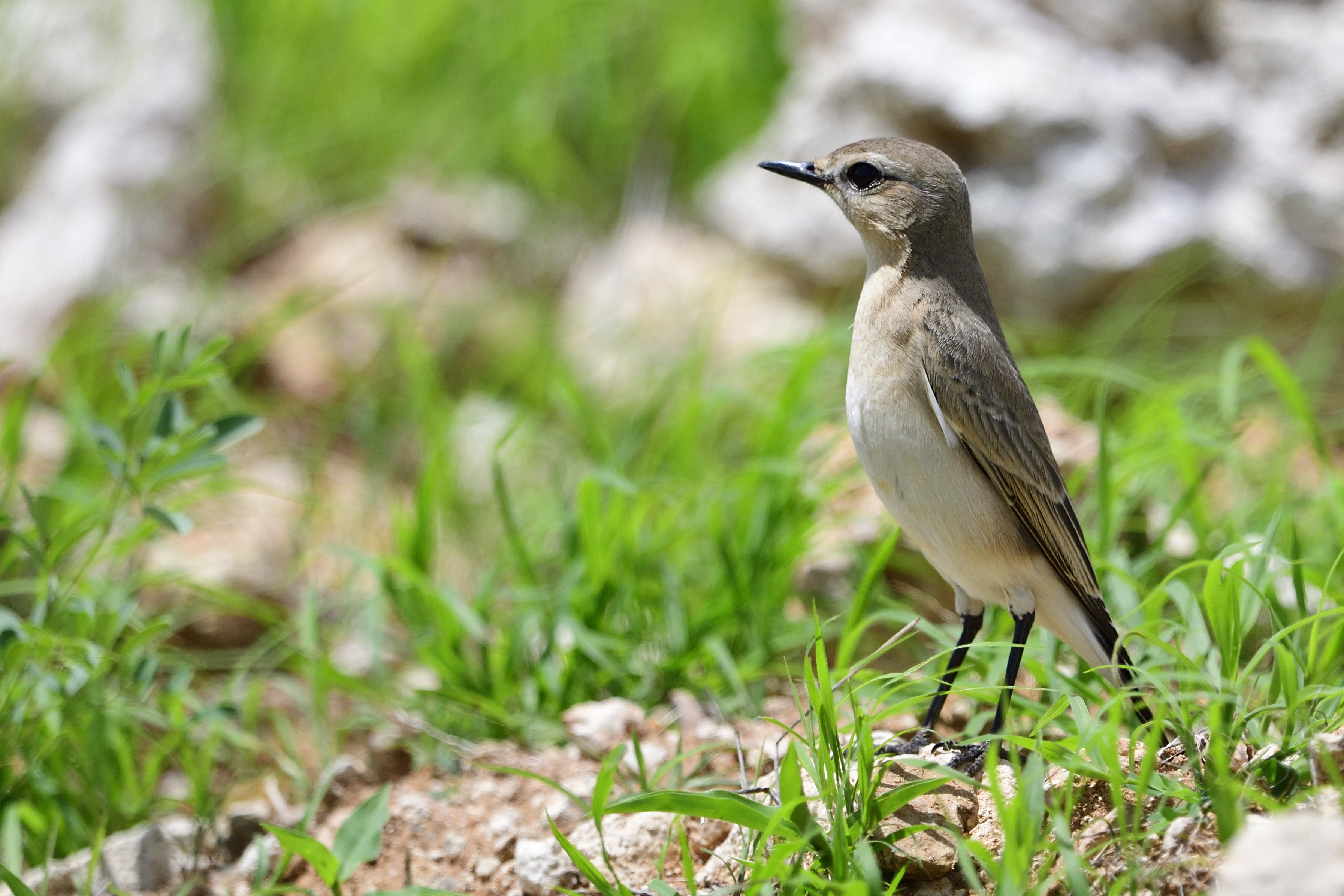
Northern Wheatear, Oenanthe oenanthe

Somali Courser, Cursorius somalensis

Kori Bustard, Ardeotis Kori

White-bellied Bustard, Eupodotis senegalensis

Crab Plover, Dromas ardeola
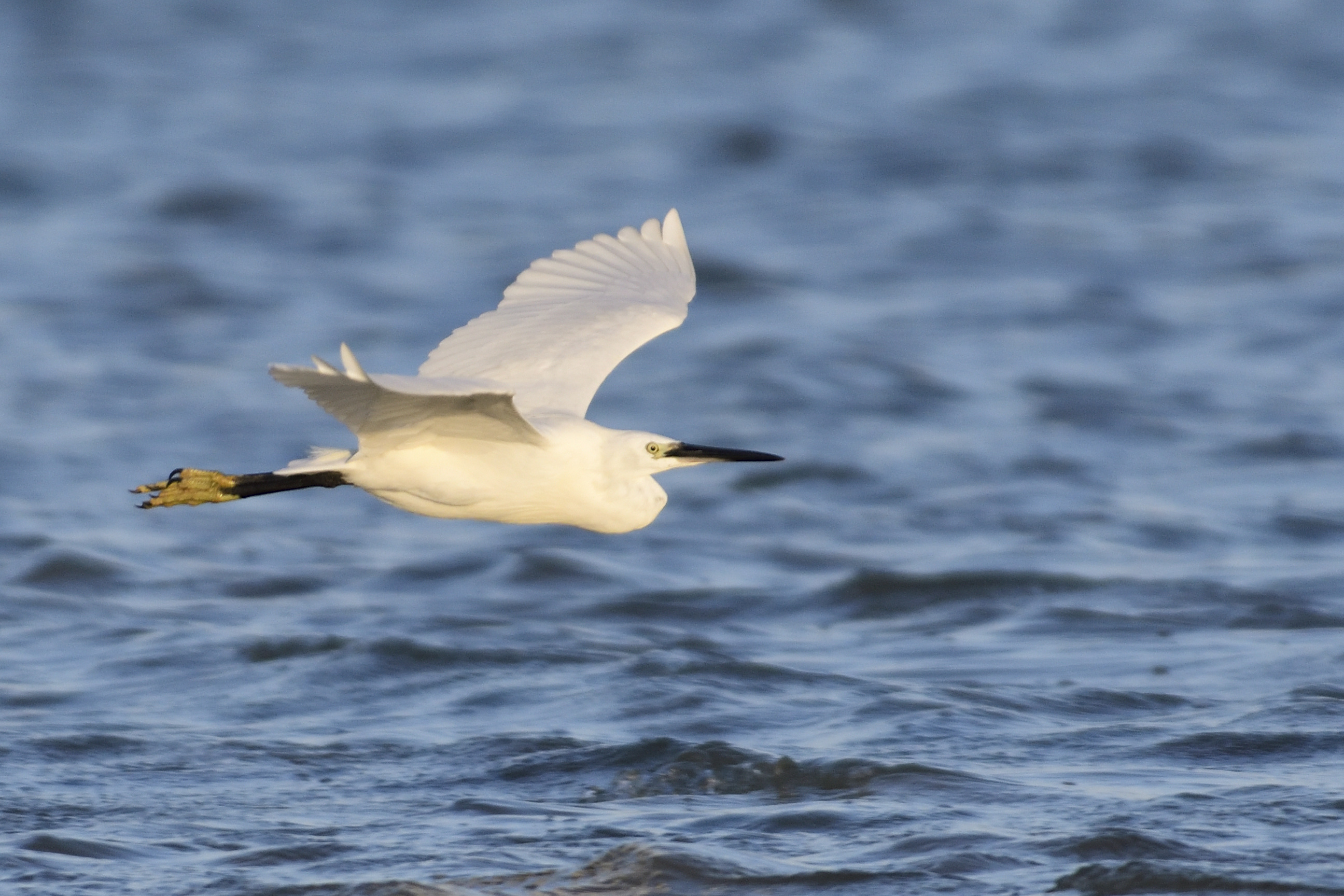
Dimorphic Egret, Egretta dimorpha
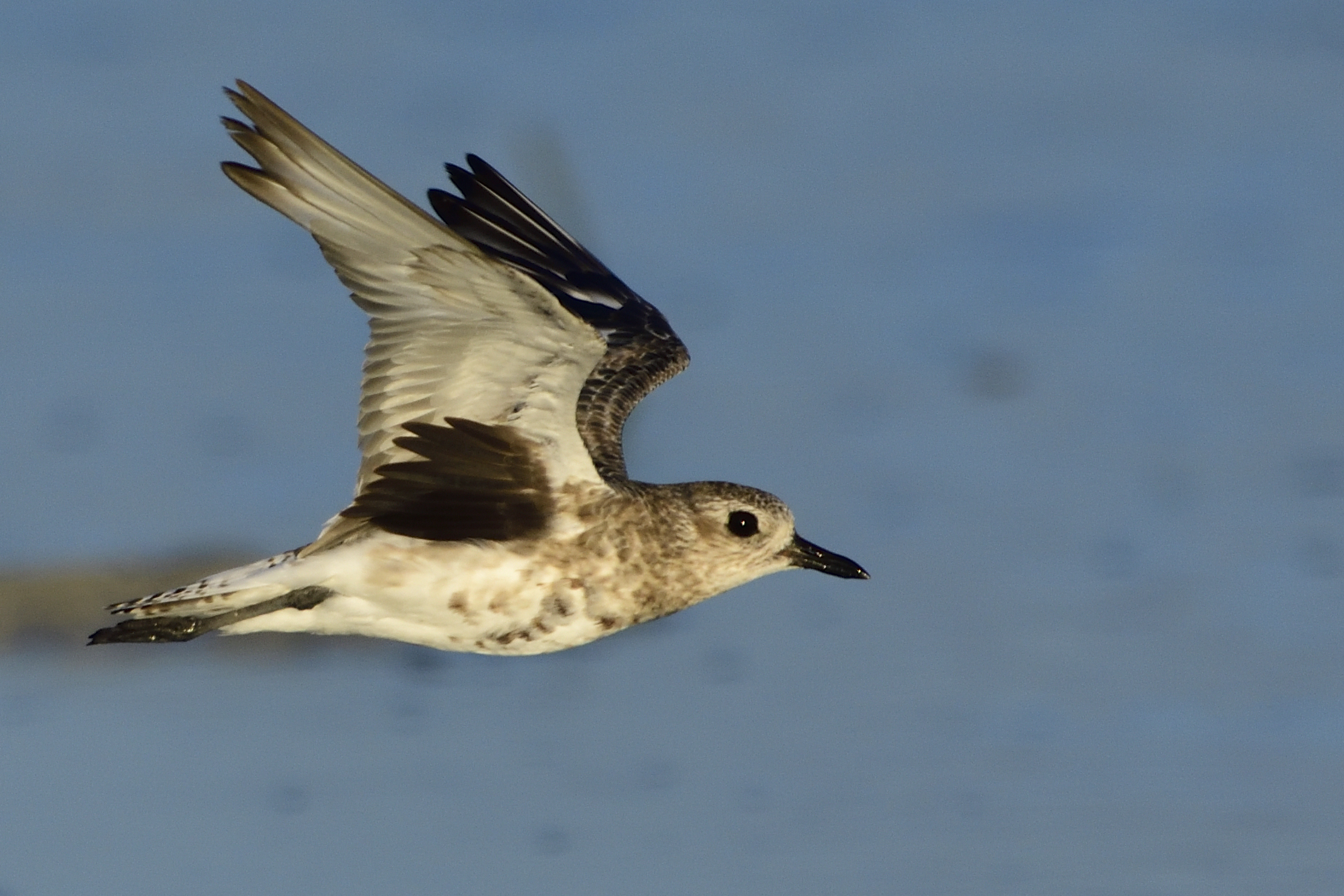
Grey Plover, Pluvialis squatarola
Day 30, October 21 – Araboku Sokoke Forest and Sabaki River Mouth
We met Willy at the entrance to the forest and our first stop was for the Sokoke Scops Owl. Willy told us to wait at the car and we waited and waited for almost 2 hours. Sybrand was in the numbers game so to wait 2 hours in the best time of the morning was a completely waste of time. Willy finally returned from the forest without having found the Owl. That made it even worse. I had found a Forest Batis while Willy was gone. Now we started birding: Lowland Tiny Greenbul, East Coast Boubou, Red-tailed Ant Thrush, Chestnut-fronted Helmetshrike, Yellow-bellied Greenbul, Dark-backed Weaver, Mombasa Woodpecker, Little Yellow Flycatcher, Red-capped Robin-Chat, Georgeous Bushshrike (heard), Green Barbet, and Eastern Nicator was recorded during the morning session. We met one of the other local guides, Albert, in the forest. He was with a non birding group, but had still found the owl. At any rate, we finished our morning birding in Araboku Sokoke and Willy had arranged for a boat trip to Whale Island in the afternoon. We went to the office and paid for the ticket. Then amongst the rangers a big discussion started. We wondered what was going on and they told us that we were not aloud to go to Whale Island to watch birds because the sea was too heavy. I looked at the sea and it was flat as a floor. I told them that and soon it surfaced that the director of the rangers did not want anyone to go there. They told us we could go snorkling instead. We were also told that there were no refund on our tickets. I was starting getting really annoyed now. We tell them we were going to Whale Island, they sell us the tickets, then they change their mind and will not refund us. They suggested we go and speak with the manager himself. We went to his compound, and waited for one hour until we found out that he was not there. We went back to the ticket office and finally got him online. He was very rude and there was no way we could go there. The staff were nice to us and said, give the tickets back and if we can sell them, we will pay you back. What choice did we have. I then asked Willy if he had ever taken people there before, and he said no. Sybrand came all the way from SA to get some terns and I was absolutely furious. We asked Willy to see if Albert was available and if he could come with us. Albert was willing and he came with us. We went straight back to Arabuko Forest. Albert disappeared into the forest once, came back after 5 minutes, no Owl. I drove on just a few hundred meters, he went in again and came back and told us to follow him. Just a few hundred meters inside the forest we had two Sokoke Scops-Owls on their day roost. We ticked Fischer´s Greenbul and East Coast Akalat as well before we exited the forest. Albert and Willy wanted to take us to the Sabaki River Mouth. It was already getting late, but what did we know. When we parked the car and started walking, we realised that it was a very long walk. On the way to the waters edge, we picked up Sombre Greenbul, Black-crowned Tchagra, Coastal Cisticola, Dodson´s Bulbul, and a lifer, Violet-breasted Sunbird. We continued walking and walking and in the end, we reached the water. There must have been more than 1.000 Fulvous Whistling Ducks there. Other birds: White-fronted Plover, Ruddy Turnstone, Caspian Tern, Lesser Black-backed Gull, White-faced Whistling Duck, Bar-tailed Godwit, Eurasian Curlew, Gull-billed Tern and Sanderling. All the birds were quite far away and we did not have time to look for any tern roosts. It was now already 17:00 and I knew we had more than 30 minutes walk back to the car and more than an hour drive back to camp. I hate driving in the dark in Africa, so we started on the way back. When we got out of the Sand dunes, we found a Golden Palm Weaver. Then Wolly-necked Stork, Bare-eyed Thrush, Long-tailed Fiscal and a group of Scaly Babblers. I needed pictures of the Babblers. Last time I had no luck and this time the same. They flew from bush to bush and always landed inside the bush. Did not react to calls at all. We then got busy trying to get better pictures of the Violet-breasted Sunbird and succeeded with that. When we got back to the car, it was already starting to get dark. We had a long drive back in the dark and I was wondering why they took us there in the afternoon when we had a full day the day after? Sybrand and I had dinner and then straight to bed.
Some pictures from Day 30:

Sybrand and me waiting for our guide that disappeared in the forest.

Little Yellow Flycatcher, Erythrocercus holochlous – Endemic to Coastal East Africa
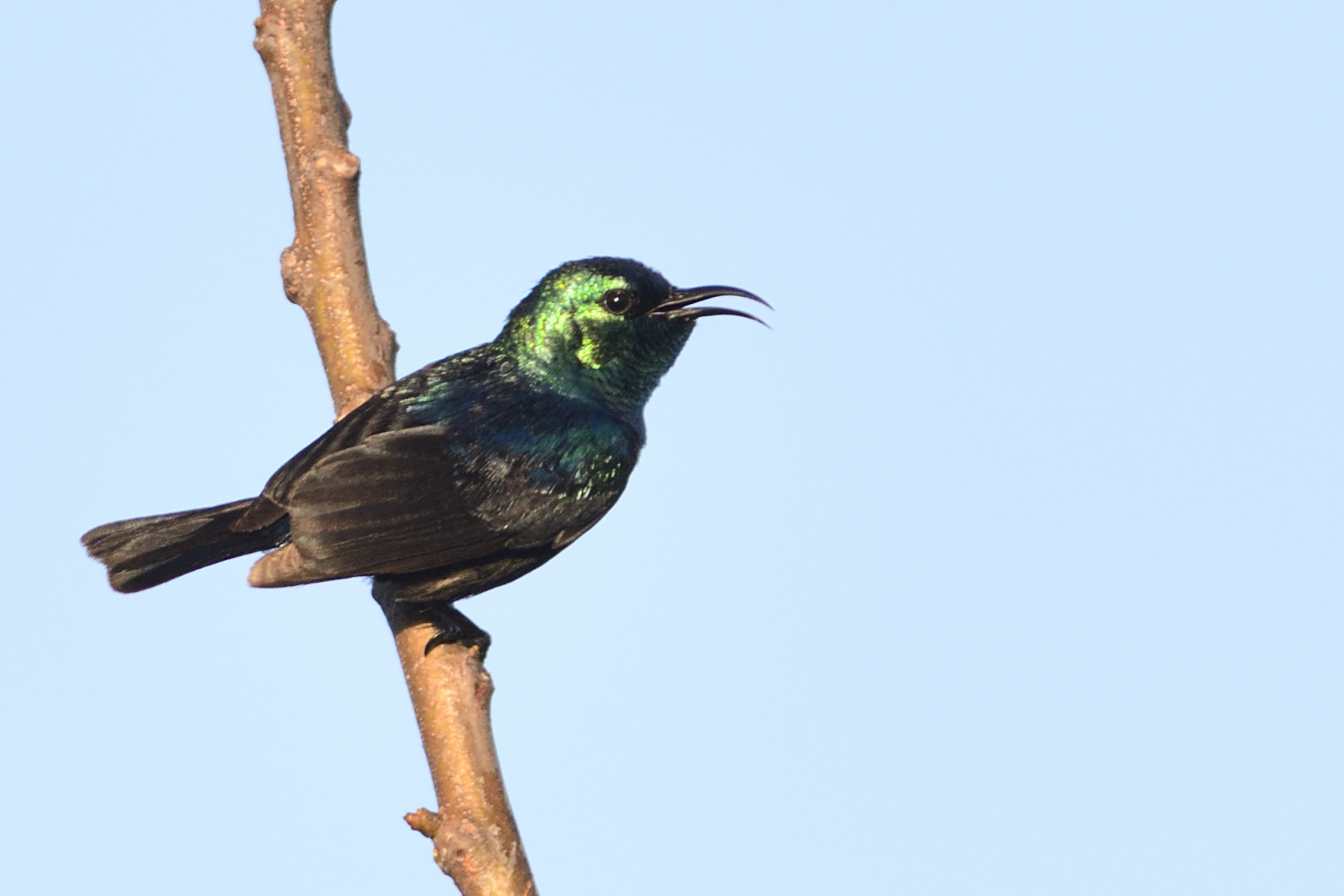
Violet-breasted Sunbird, Cinnyris chalcomelas – Endemic to NE Africa – Lifer
Day 31, October 22 – Watamu area
Willy had a place for Malindi Pipit. It turned out to be quite a walk in pretty wet habitat, so I stayed in the car. They came back after quite some time and had bagged the Pipit and also a Zanzibar Red Bishop. We went back to Arabuko Sokoke in the afternoon. One of the targets were Sokoke Pipit. we spent a long time searching for the bird at many places, however no luck. We did find Clarke´s Weaver, Narina Trogon, Pale Batis, Eastern Nicator and Little-spotted Woodpecker. It was all in all a very quiet day.
Day 32, October 23 – Watamu to Taita Hills
We were soon on our way to Taita Hills. Quite a drive, but it went quite smoothly. I had only been there once before and wondered if i would manage to navigate all the small roads that would eventually lead to the camp in Ngangao Forest. It went like a dream and after about 5 hours in the car, we arrived safely. Nataniel and Maina was there to meet us. We were assigned a tent each and wasted no time to go out birding. The first target was Taita Apalis. It was nesting season and Maina knew exactly were some nests were. However; during this season the birds become very shy. We had fleing glimses off a few birds, but no photo opportunity. Poor Sybrand in our search was attacked by Safari Ants and had to strip totally to get rid of those pesky critters. Having bagged one of the Taita endemics, the Trush was our next target. We went to the same place I managed to photograph it last time and got it, not good views, but good enough for Sybrand to tick it. We looked for the Taita White-eye, but could not locate it. Two of the tree Taita endemics were a good start though. The ladies cooked us a nice meal and we retired to our tents.
Picture from Day 32
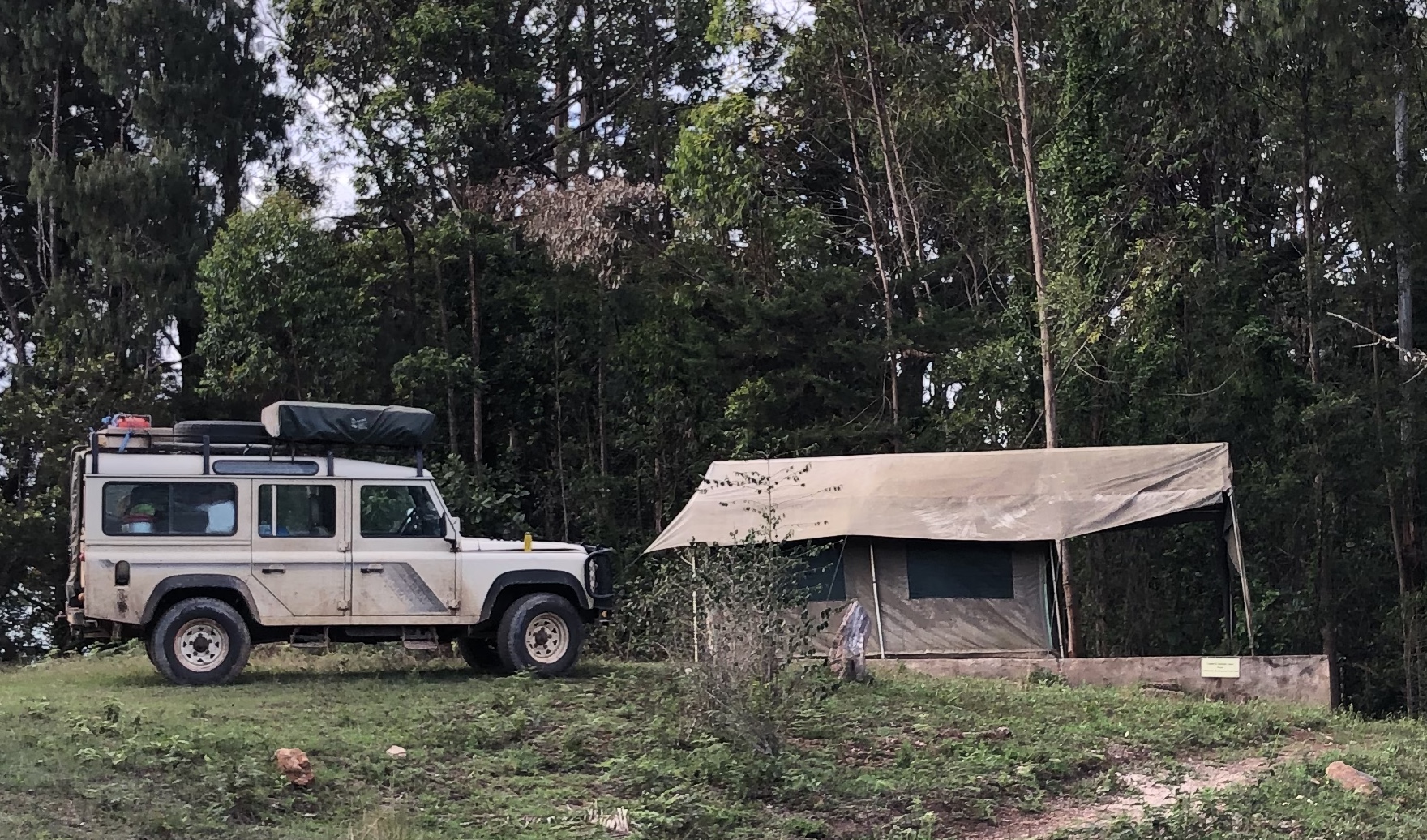
Lizzie and my home for the night in Taita Hills
Day 33, October 24 – Taita Hills, Kenya to Kiligolf, Tanzania
Last time, the Taita White-eye proved to be the hardest bird to get a proper picture off. Sybrand had a little ace of his sleeve though. He had downloaded the local call from Xeno-canto and boy did it work? the bird went absolutely ballistic and provided fantastic photo opportunities. Our mission in Taita Hills were accomplished. We packed the car and were soon on our way home. I got a big surprise at the Kenyan side of the Taveta border. It turned out that I had 3 days left of my previous Kenyan visa when we crossed the border on October 7. They asked how long we were staying in Kenya, I told them 3 weeks. I did not think anymore about it before I reached the border at Taveta. The lady said I had over stayed with more than 10 days and needed to pay a $500 fine. To make a long story short, after 2 hours of waiting, I paid the fine and of course no receipt. We continued in to Tanzania and finally arrived late afternoon. I just had to drop Sybrand off and then I rushed straight to the airport to pick up Selvine. I was just in time and very happy to see her well again. We drove home and she fixed us a nice meal. We slept well that night.
Picture from Day 33:

Taita White-eye, Zosterops silvanus – Endemic to Taita Hills, Kenya
Day 34, October 25 – Kiligolf to Kilimanjaro International airport
During breakfast this morning, Sybrand and I did the total tally for the trip. Sybrand had 1166 birds when he arrived, now he was at 1397. So together with my guides, we added 231 birds to his list in 33 days, so an average of 7 new birds pr. day. If we had only managed to go to Whale Island, we could have reached my goal at 1400, but 3 birds shy of a super stretched goal was not too bad. Some more numbers: In Tanzania Sybrand saw 314 species with me where 119 were new birds. In Kenya he saw 407 species where 112 where new species. In my birdlasser I recorded 582 species of the m 231 was new birds for Sybrand. so of the total number of birds we saw 40% of the birds were new birds for Sybrands African Big Year List. Sybrand has a blog describing his big year. I will absolutely recommend to read it. His prose is fantastic and it is an exiting read. Check out vagranttwitcher.wixsite.com/bigyear/blog-1. After breakfast , the only thing remaining was for me to take Sybrand back to the airport. His next destination was Pemba Island off the coast of Tanzania, where he managed to get all 4 endemics + and extra bird in form of a Java Sparrow. Due to the fact that we extended Sybrands trip with a few days, I only had 2 days available for my next guests to arrive on October 27. Stay tuned for the next trip report